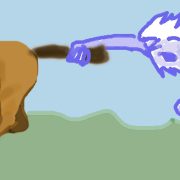All the King’s horses
This is going to be a very equine blog. As one gets older, the more challenging the climb up Bradlow Hill becomes, and the more one wishes for a horse. The weather was breezy, and there was a lot of Red Campion about in the wood, having taken over from the Bluebells – the moment when both overlap would have been a month ago: a sea of blue and pink.
Recently I took up the birthday gift by my children of a riding lesson in the Western style, not far from Ledbury, in a place called Ullingswick. It was more fun than expected, given that the last time I sat on an animal was in 1967, and the tolerance of April (my horse) was impressive, as is the fact that I did not fall off. The Western style encourages the rider and horse to become one, with the former using his or her body to guide the horse, who responds to pressure from a knee or a shift in weight.
April had all the qualities of a ceramicist: patience, perseverance, stoicism, and equanimity (a habit of mind that is only rarely disturbed under great strain). If she had fingers rather than hooves, she would make a good potter.
Earlier in the week I was in St John’s Wood to deliver some ceramics to the Cecilia Colman Gallery, which you may remember from a previous blog, has been operating for forty-five years. It’s an established star in the ceramics firmament.
Regent’s Park and Zoo are nearby, lots of shops, but also some fine residential buildings built in the late 19th century Streaky Bacon style, or ‘Constructional Polychromy’ – alternating bands of brick and marble, which was popular with British architects. I mention architecture in order to show you a recent piece from the kiln called Construct. There is an affinity between ceramicists and architects in that both vessels and buildings are ways of filling space (discuss).
I was a little early, so I went to a café. A morning coffee isn’t always accompanied by the unexpected thrill of a seemingly endless column of beautiful chestnut horses clip-clopping their way past the large windows of a London café on its way to Regent’s Park. There must have been over forty, twenty riderless, that passed by with an air of disdainful boredom, as if the gawping pedestrians confirmed all their prejudices about two-legged beings.
The barista confirmed that this was a regular occurrence. Based in St Johns Wood, the King’s Troop Royal Horse Artillery is responsible for firing royal and ceremonial salutes as part of the sovereign’s birthday parade in April, the state opening of parliament, state visits and Remembrance Day. The barista was a talented joker. When I said I thought they were beautiful thoroughbreds, he told me he had once I put a bet on a horse that had excellent breeding, and that after it left the starting gate, it stopped and closed it behind him.
Unable to get horses out of my mind, I inevitably resorted to finding out a bit more about them. So, did you know that horses can sleep both lying down and standing up, thanks to a special locking system in their legs? You’ll like this: when foals are born their hooves are covered with soft tissue which stops their mothers’ birth canal and uterus from being damaged – they are called fairy slippers.
Horses produce 10 gallons of saliva a day – saliva has very important functions because it wets feed material and begins to break it down. It also has an important buffering effect in the stomach, reducing acidity. Since we are talking of these matters, above is a picture I took in Bradlow Knoll of some Cockoo Spit, which has nothing to do with horses’ saliva. Inside each mass of cuckoo spit is a juvenile yellow-green froghopper.
The adult froghoppers or spittlebugs are 6mm long and bright green, with large eyes and a blunt-shaped head, but they’re rarely seen because they hop away on their strong back legs at the first sign of danger. We all know people like that – excepting the “bright green” bit, I assume.
With the excuse that a froghopper looks like a plump cricket, here in St John’s Wood is the home of the sport. Lord’s has been the birthplace of cricket since 1787, but looking at the grounds from outside one has to admit that they’ve moved on with the times, and their roofscape is nice mixture of the old and the new. They say that if cricket wasn’t so difficult to understand, most of its obsessives and followers might never have bothered with it at all. Here are some of the fielding positions players take up: Deep point, Backward point, Deep backward point, Short third, Deep third, Short leg, Square leg, Deep square leg, Backward square leg, Long leg, Short fine leg, Deep fine leg, etc.
Most people have some sort of obsession, major or minor, though cricket is not one shared by the team here at Peter Arscott Ceramics (PAC). Spiro (Marketing) has a passion for goat yoghurt, Ziggy (fly-catching) is forever pondering the significance of Proust’s “A la Recherche du temps Perdu” and Shinto (the pugmill) goes on and on about sushi. In my case it’s Picasso’s Demoiselles d’Avignon that has always bothered me – it’s the elbow sticking out at the top, centre, of the painting, which the vase below always reminds me of.
A horse walks into a bar. “Hey,” says the barman. “Yes please,” says the horse.























